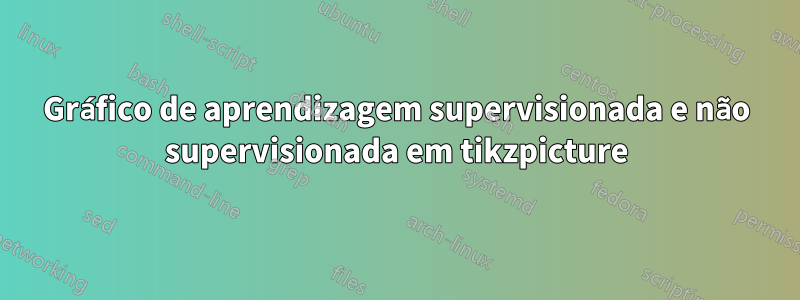
Eu gostaria de representar esses dois gráficos usando tikzpicture. Não preciso deles unidos como abaixo, mas gostaria de ter algo semelhante.
Posso gerar um gráfico de dispersão conforme abaixo:
Onde tenho dois clusters únicos/distintos. Gostaria de traçar a linha linearmente separável como no exemplo de aprendizagem supervisionada, ao mesmo tempo que desenhava os agrupamentos no exemplo de aprendizagem não supervisionada.
Além disso, ter as cores/pontos maiores seria ótimo.
Código:
\documentclass{article}
\usepackage{pgfplots}
\begin{document}
\begin{tikzpicture}
\begin{axis}[%
axis lines = left,
xlabel = x,
ylabel = y,
]
\addplot[only marks] table [%
x = x,
y = y,
col sep = comma]{
x, y
%cluster 1
2, 3
3, 5
4, 5
3, 8
5, 9
3, 2
5, 6
6, 6
7, 9
10, 4
11, 5
9, 4
%cluser 2
20, 10
21, 12
24, 12
25, 13
27, 14
22, 13
23, 15
25, 10
15, 14
};
\end{axis}
\end{tikzpicture}
\end{document}
Responder1
Você poderia usar scatter/classespara formatar os pontos dos dois clusters de maneira diferente, mas é mais fácil simplesmente dividi-los em dois \addplots. Para definir a formatação, use, por exemplo \addplot [blue, only marks, mark=*, mark size=5] ..., que são em sua maioria autoexplicativos, eu acho.
Para a linha e os círculos é quase apenas um caso de usar comandos normais do TikZ. Apenas observe que, por padrão, se você fizer isso \draw (x,y) ..dentro de um axisambiente xe ynão estiver no sistema de coordenadas do arquivo axis.A menos quevocê a) usa (axis cs:x,y)ou b) adiciona \pgfplotsset{compat=1.11}(ou um número de versão superior), caso em que axis csse torna o padrão.
Observe ainda que a circle[radius=2]dentro de an axisrequer compat=1.11(eu acho), mas o raio está novamente nas coordenadas do eixo, portanto, neste caso, ele se tornaria uma elipse. O que você poderia fazer é definir uma coordenada dentro de axise desenhar o círculo fora dela. Ambos são demonstrados no código abaixo.
\documentclass{article}
\usepackage{pgfplots}
\pgfplotsset{compat=1.11} % <-- added
\begin{document}
\begin{tikzpicture}
\begin{axis}[%
axis lines = left,
xlabel = $x$,
ylabel = $y$,
clip mode=individual % so things drawn by \draw and similar are not cut off
]
\addplot [blue, only marks, mark=*, mark size=5] table [%
x = x,
y = y,
col sep = comma]{
x, y
%cluster 1
2, 3
3, 5
4, 5
3, 8
5, 9
3, 2
5, 6
6, 6
7, 9
10, 4
11, 5
9, 4
};
\addplot+[red, only marks, mark=*, mark size=5] table [%
x = x,
y = y,
col sep = comma]{
x, y
20, 10
21, 12
24, 12
25, 13
27, 14
22, 13
23, 15
25, 10
15, 14
};
% to be able to use axis coordinates with \draw directly you need
% \pgfplotsset{compat=1.11} or a higher version
% if that is not present, use (axis cs:4,14) instead of (4,14),
% to specify that the values should be interpreted as axis coordinates
\draw [dashed] (4,14) -- (25,2);
% save a coordinate for use later
\coordinate (c2) at (23,12);
% the blue circle is drawn inside the axis environment, and in axis coordinates
% hence it becomes an ellipse
\draw [blue, dashed] (6,6) circle[radius=5];
\end{axis}
% the red circle is drawn outside the axis, so actually looks like a circle,
% but the radius has no relation to the axis coordinates
\draw [red, dashed] (c2) circle[radius=2cm];
\end{tikzpicture}
\end{document}
Dois eixos
Existem vários métodos para obter dois gráficos próximos um do outro. Você pode adicionar dois tikzpictures um após o outro, ou pode ter dois axisambientes no mesmo tikzpicturee posicionar o segundo com \begin{axis}[at={(x,y)},.... Pessoalmente gosto do groupplotambiente da groupplotsbiblioteca, que serve para fazer grades de eixos.
\documentclass{article}
\usepackage{pgfplots}
\usepgfplotslibrary{groupplots}
\pgfplotsset{compat=1.11}
\begin{document}
\begin{tikzpicture}
\begin{groupplot}[
group style={
group size=2 by 1,
horizontal sep=1.5cm
},
axis lines = left,
xlabel = $x$,
ylabel = $y$,
width=5cm, % <-- set size of axes
clip mode=individual, % to avoid \draws being cut off
title style={yshift=1mm, font=\bfseries\sffamily}
]
\nextgroupplot[title=Supervised learning]
\addplot [blue, only marks, mark=*, mark size=3] table [%
x = x,
y = y,
col sep = comma]{
x, y
%cluster 1
2, 3
3, 5
4, 5
3, 8
5, 9
3, 2
5, 6
6, 6
7, 9
10, 4
11, 5
9, 4
};
\addplot+[red, only marks, mark=*, mark size=3] table [%
x = x,
y = y,
col sep = comma]{
x, y
20, 10
21, 12
24, 12
25, 13
27, 14
22, 13
23, 15
25, 10
15, 14
};
% to be able to use axis coordinates with \draw directly you need
% \pgfplotsset{compat=1.11} or a higher version
% if that is not present, use (axis cs:4,14) instead of (4,14),
% to specify that the values should be interpreted as axis coordinates
\draw [dashed] (4,14) -- (25,2);
\nextgroupplot[title=Unsupervised learning]
\addplot [blue, only marks, mark=*, mark size=3] table [%
x = x,
y = y,
col sep = comma]{
x, y
%cluster 1
2, 3
3, 5
4, 5
3, 8
5, 9
3, 2
5, 6
6, 6
7, 9
10, 4
11, 5
9, 4
};
\addplot+[red, only marks, mark=*, mark size=3] table [%
x = x,
y = y,
col sep = comma]{
x, y
20, 10
21, 12
24, 12
25, 13
27, 14
22, 13
23, 15
25, 10
15, 14
};
% save a coordinate for use later
\coordinate (c2) at (23,12);
% the blue circle is drawn inside the axis environment, and in axis coordinates
% hence it becomes an ellipse
\draw [blue, dashed] (6,6) circle[radius=5];
\end{groupplot}
% the red circle is drawn outside the axis, so actually looks like a circle,
% but the radius has no relation to the axis coordinates
\draw [red, dashed] (c2) circle[radius=1cm];
\end{tikzpicture}
\end{document}






